- Basic SEO Checklist
- Technical SEO Checklist: A Guide to SEO Technical Optimization
- SEO Keyword Research Checklist
- On-Page SEO Best Practices Checklist for 2024
- 1. Check and fix Missing and duplicate Meta Titles
- 2. Check and fix missing and duplicate meta description
- 3. Check and fix missing and duplicate H1, H2
- 4. Use short and descriptive URLs
- 5. Internal linking and External linking
- 6. Write descriptive Image Alt text name
- 7. Add Schema
- 8. Check and fix 404 error and 301 redirection
- Content Checklist
- Link Building Checklist

As search engine algorithms evolve, it is crucial for businesses and website owners to stay updated with the latest SEO best practices.
To ensure your website remains competitive and visible in search engine results, we present the complete SEO checklist for 2024.
This ultimate SEO checklist outlines essential factors and strategies to optimize your website, enhance user experience, and boost organic traffic.
By following these factual guidelines, you can strengthen your online presence and achieve higher rankings on search engine results pages, driving more valuable traffic to your website.
Basic SEO Checklist
If you’re launching a new website, understanding SEO basic for website is crucial to ensure your online presence gets off to a great start.
This Basic SEO Checklist will guide you through essential optimization practices to improve your website’s visibility in search engines and attract organic traffic.
By implementing these fundamental SEO strategies, you’ll be well on your way to reaching a broader audience and maximizing your online potential.
Let’s dive in and explore the key elements of basic SEO checklist for website!
1. Set up Google Search Console

Google Search Console is a powerful tool that allows you to monitor, analyze, and optimize your website’s presence in Google search results.
To get started, sign in with your Google account, add your website property, and verify it (Google will guide you through the process).
Once set up, you can check:
- crawl errors
- submit sitemaps
- view search analytics
and more, giving you invaluable insights into your site’s performance.
2. Set up Google Analytics
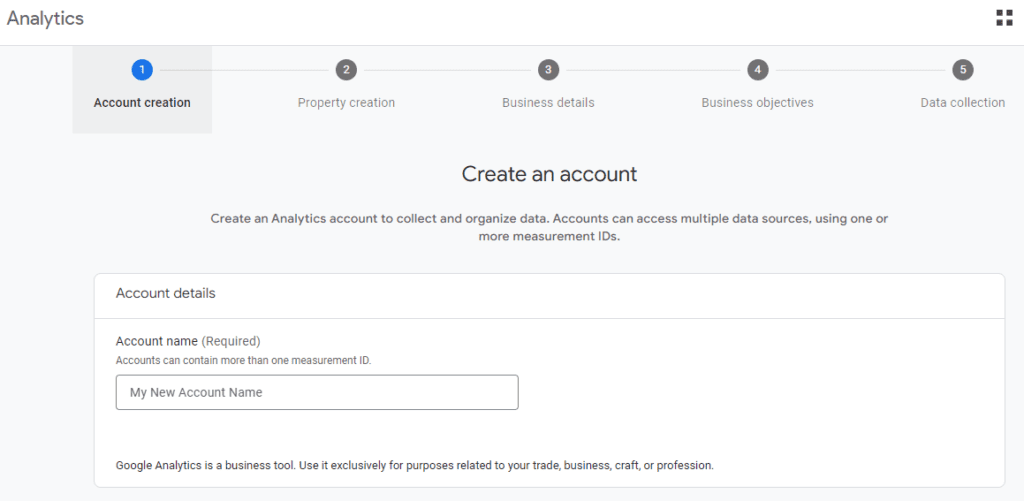
Understanding your website’s audience and their behavior is essential for successful SEO.
Google Analytics provides detailed data on traffic sources, user demographics, popular content, and much more.
To set up Google Analytics, create an account, get your unique tracking code, and add it to your website.
With this data, you can tailor your content and marketing efforts to cater to your target audience.
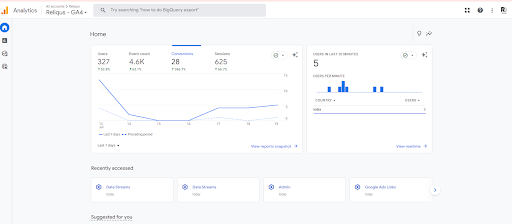
3. Install an SEO Plugin i.e. Rank Math, Yoast
If your website runs on WordPress or another CMS, installing an SEO plugin like RankMath or Yoast can be a game-changer.

These plugins offer features such as on-page SEO analysis, keyword optimization, XML sitemap generation, and even social media integration.
Follow the plugin’s instructions to set it up properly and make the most of its SEO functionalities.

4. Create and submit the sitemap
A sitemap is a list of all the pages on your website that helps search engines understand its structure and content. Creating an XML sitemap is relatively easy, especially if you’re using an SEO plugin.

Once you have it ready, submit it to Google Search Console and other search engines you want to target. This will ensure your website’s pages get indexed efficiently and accurately.
5. Create Robots.txt file

The Robots.txt file is a simple text file placed on your website’s root directory to instruct search engine crawlers which pages or sections should not be crawled or indexed.
It’s essential to have a well-structured Robots.txt file to prevent the indexing of unnecessary or sensitive pages and ensure that search engines focus on the right content.
6. Add Project to Ahref or SEMRush
Tools like Ahrefs or SEMRush are powerful resources for conducting competitive research, keyword analysis, backlink monitoring, and more.

By adding your project or website to these tools, you can gain valuable insights into your competitors, identify new keyword opportunities, and improve your overall SEO strategy.
Technical SEO Checklist: A Guide to SEO Technical Optimization
From the crucial technical SEO list to mastering the art of SEO technical optimization, this guide will equip you with the knowledge and strategies to enhance your website’s performance and boost its visibility on search engines. Let’s dive in and uncover the key factors that will propel your website to the top of search engine rankings!
1. Plan your website structure
A well-organized website structure not only helps users find information easily but also enables search engines to navigate and index your content efficiently.
Consider creating a logical hierarchy of categories and subcategories, making sure each page is reachable within a few clicks.

A clear sitemap and navigation menu will guide both users and search engine bots through your website effectively.
2. Make sure your site is Indexable
Search engines need to access and crawl your website’s pages to index them in their databases.
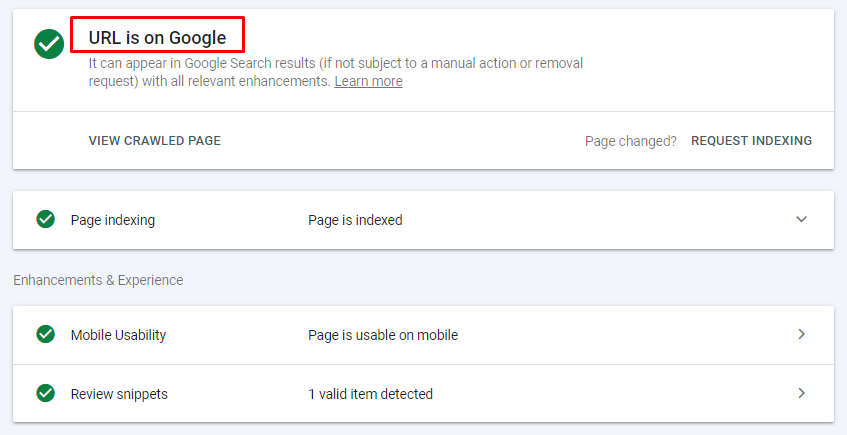
Avoid using elements like JavaScript, Flash, or certain types of dynamic content that might hinder search engine bots from crawling your site effectively.
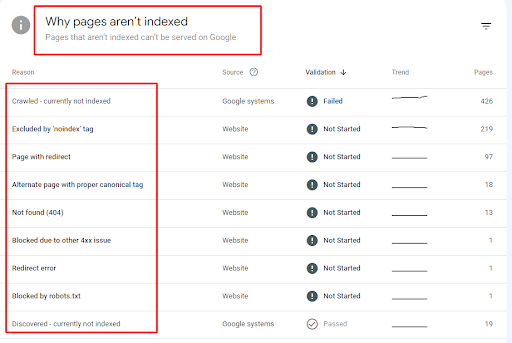
Use robots.txt and sitemap.xml files to communicate with search engines and control which pages they should crawl and index.
3. Make sure you’re using HTTPS
Security is a top priority for search engines, and using HTTPS (Hypertext Transfer Protocol Secure) encrypts data transmitted between the user’s browser and your website.

Not only does HTTPS build trust with your visitors, but it is also a ranking factor for search engines.
Ensure your SSL certificate is up-to-date to protect user data and boost your website’s SEO.
4. Make sure your site is loading fast
In the fast-paced online world, nobody likes a slow-loading website. Page loading speed directly affects user experience and impacts search engine rankings.
Compress images, leverage browser caching, and minimize unnecessary code to improve your site’s loading times. Mobile users, in particular, appreciate a speedy website.

You can use tools like PageSpeed Insights and GTMetrix to see how fast your web page loads.
5. Make sure your image is less than 100 kb
High-quality images add visual appeal to your website, but they can also slow down its loading speed.
Compress your images without compromising on quality to reduce their file size. Aim to keep image sizes below 100KB, ensuring faster page loading times and a smoother user experience.
6. Fix Broken Pages
Broken links and 404 error pages frustrate both users and search engines.
Regularly audit your website for broken links and fix or redirect them to relevant pages.

This will help retain users, maintain good user experience, and preserve your SEO efforts.
7. Fix duplicate content issues
Search engines prefer unique and original content. Duplicate content can confuse search engines, affecting your site’s rankings and visibility.
Tools: Copyscape

Use canonical tags, 301 redirects, or consolidate duplicate pages to ensure search engines attribute the correct version of your content.
8. Make sure your site is mobile friendly
With the increasing use of mobile devices, having a mobile-friendly website is no longer optional but a necessity.

Responsive web design ensures that your site adapts to different screen sizes and devices, providing an optimal experience for mobile users. Google prioritizes mobile-friendly websites, so this step is crucial for your SEO strategy.
SEO Keyword Research Checklist
Keyword research is an essential process in Search Engine Optimization (SEO) that involves identifying and analyzing the words and phrases individuals employ while searching for information, products, or services on the internet.
It plays a crucial role in tailoring your content to align with your target audience’s search intent. To ensure effective SEO, focus on optimizing keywords, employing keyword optimization tips, utilizing a SEO Keyword Research Checklist, and selecting the right keywords for website search optimization.
1. Research what people are searching
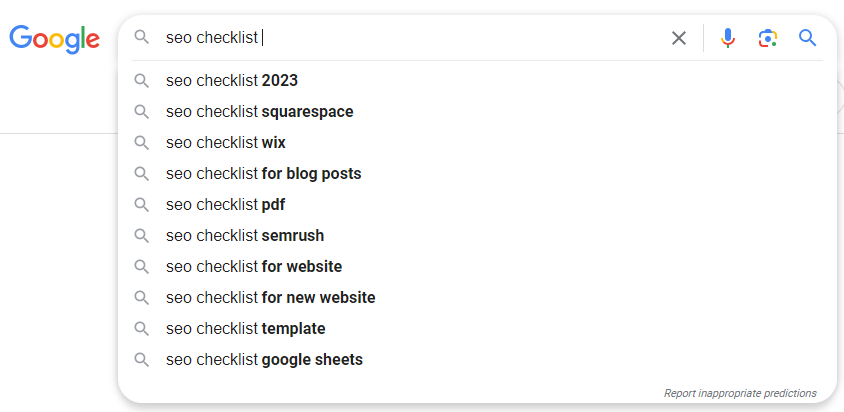
To begin, put yourself in your audience’s shoes. Think about what questions they might have or what terms they’d use to find what you offer.
Use search engines, social media, and forums to discover common queries related to your niche.
2. Find Primary Keywords
Primary keywords are the main topics that represent your content or business. These are typically broader terms with higher search volumes.
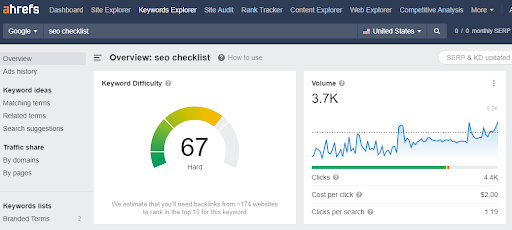
Use tools like Ahrefs, Google’s Keyword Planner, or SEMRush to identify relevant primary keywords that best align with your content.
3. Find Secondary Keywords
Secondary keywords are more specific and related to your primary keywords. They usually have lower search volumes but can be valuable for targeting a specific audience.

Tools like Ahrefs and Ubersuggest can help you discover relevant secondary keywords.
4. Check Search Intent
Understanding the search intent behind keywords is essential. Ask yourself: Are people looking for information, wanting to buy, or looking for something else?
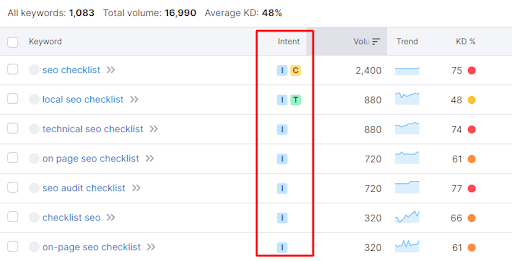
Tailor your content to match the user’s intent to increase engagement and conversions.
5. Find competitor keywords
Analyze your competitors to see what keywords they are targeting.

Tools like MOZ and SEMRush provide competitor analysis, helping you identify potential opportunities and gaps in your strategy.
6. Assess your chances of ranking
Consider the competitiveness of keywords. High search volume keywords might be challenging to rank for, especially if your website is new or lacks authority.
Balancing high-competition and low-competition keywords can give your content a better chance of ranking well.
7. Use tools – SEMRush, Ahref, MOZ, Ubersuggest
These tools mentioned earlier are essential for an effective keyword research process. They offer valuable insights into search volumes, keyword difficulty, competitor analysis, and more.
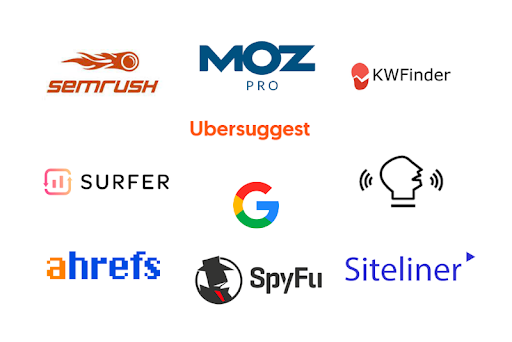
8. Use low-hanging fruit keywords

Low-hanging fruit keywords are those with decent search volumes and relatively low competition. Targeting these can provide quick wins for your SEO efforts and help your website gain traction.
We are sharing a detailed tutorial on Keyword Research, you can watch
On-Page SEO Best Practices Checklist for 2024
On-Page SEO plays a pivotal role in enhancing your website’s search engine rankings and attracting more organic traffic. This optimization technique involves strategically implementing SEO best practices on your website’s pages to boost their relevance and user-friendliness.
To achieve the best results, it’s essential to follow an on-page SEO best practice checklist diligently.
1. Check and fix Missing and duplicate Meta Titles
Meta titles are essential elements that provide search engines and users with a concise summary of what a page is about.
It’s essential to ensure that each page on your website has a unique and descriptive meta title that accurately represents its content.
Avoid duplicate titles, as they can confuse search engines and hinder your ranking potential.
2. Check and fix missing and duplicate meta description
Meta descriptions are brief snippets that appear below the title in search engine results. They give users a preview of your page’s content.
Writing compelling, unique meta descriptions can increase click-through rates and improve your website’s visibility.
Avoid using duplicate meta descriptions, as it might negatively impact your rankings.
3. Check and fix missing and duplicate H1, H2
Headers (H1, H2, etc.) help structure your content and make it easier for search engines to understand the hierarchy and relevance of your information.
Ensure each page has a clear H1 tag representing the main topic and use H2 tags for subsections.
Avoid duplicate headers, as they might confuse both users and search engines.
4. Use short and descriptive URLs
When creating URLs for your pages, opt for short and descriptive ones that include relevant keywords.
Avoid using long, confusing strings of numbers and characters.
Clear URLs not only help search engines understand your content but also make it easier for users to remember and share your links.

5. Internal linking and External linking
Internal linking refers to connecting different pages within your website. It helps search engines discover and index new content while also spreading link authority across your site.

External linking involves linking to reputable websites, which can improve your content’s credibility and authority. Strike a balance between both types of linking to enhance your SEO efforts.

6. Write descriptive Image Alt text name
When adding images to your web pages, include descriptive alt text for each image. Alt text is a text alternative that appears if an image fails to load or if a user is using a screen reader.
Optimizing alt text with relevant keywords can improve accessibility and provide search engines with more context about your content.
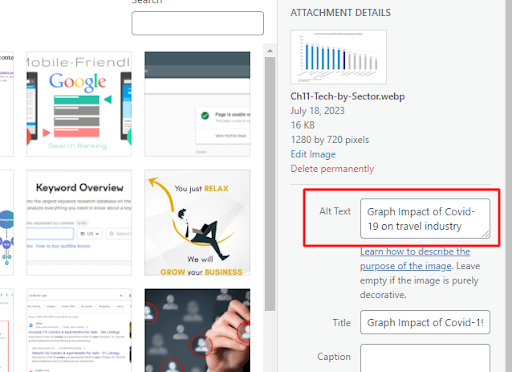
7. Add Schema
Schema markup is a structured data format that helps search engines understand the content on your website better.
By incorporating schema markup, you can enhance the way your pages are displayed in search results, potentially increasing click-through rates.

8. Check and fix 404 error and 301 redirection

404 errors occur when a page cannot be found, and they can harm user experience and SEO rankings.
Suggestion:
Regularly check for broken links and either fix or redirect them using 301 redirects to maintain link equity and prevent users from encountering dead ends.

Content Checklist
If you’re looking to create content that stands out, attracts more visitors, and boosts your search engine rankings, then you’ve come to the right place.
Content optimization in SEO is all about crafting engaging and valuable content while strategically incorporating targeted keywords to improve your website visibility and relevance in search engine results.
In this guide, we’ll walk you through a comprehensive content checklist and provide expert tips on how to optimize your content effectively.
Get ready to take your website’s performance to new heights with these powerful content optimization Checklist.
1. Solve the reader’s problem
The foundation of any great content is addressing the needs and concerns of your audience. Before you begin writing, take the time to understand your target readers and identify their pain points.
Frame your content around providing solutions and valuable insights to ensure that your readers find it relevant and beneficial.
2. Write the winning intro
The introduction is the gateway to your content, so it’s essential to make it engaging and captivating. Start with a compelling hook that piques your reader’s interest and entices them to keep reading.

You can use an intriguing question, a shocking statement, or a relatable anecdote to draw them in.
3. Make subheadings (H2,H3,H4) to create hierarchy
Well-structured content is easier to follow and digest. Utilize descriptive subheadings to break down your content into smaller, coherent sections.
H2 headings represent main sections, while H3 and H4 headings can be used for subsections.

This hierarchy not only makes your content more organized but also allows readers to skim and find the information they need quickly.
4. Use resourceful images in content to make it interesting
“A picture is worth a thousand words” – the adage holds true for content creation. Integrating relevant images, infographics, and visual aids enhances the overall appeal of your content.

Images not only make your content more interesting but also help in conveying complex concepts effectively.
5. Use short sentences and paragraph
Long, convoluted sentences can deter readers and make comprehension challenging. Opt for clear and concise sentences to deliver your message succinctly.

Break your content into shorter paragraphs to improve readability, allowing readers to grasp key points effortlessly.
Make sure paragraphs are not more than 2 lines. As it helps the user to read paragraphs clearly.
6. Add a table of content
A table of contents serves as a roadmap for your content.

Providing an outline at the beginning, you allow readers to see what to expect and navigate to specific sections directly. This feature is particularly beneficial for longer articles or guides.
7. Make content interesting with facts, stats, and quotes
Facts and statistics add credibility to your content, while quotes from experts or influential figures can provide unique perspectives.
Infuse your content with intriguing data and thought-provoking quotations to make it more compelling and memorable.
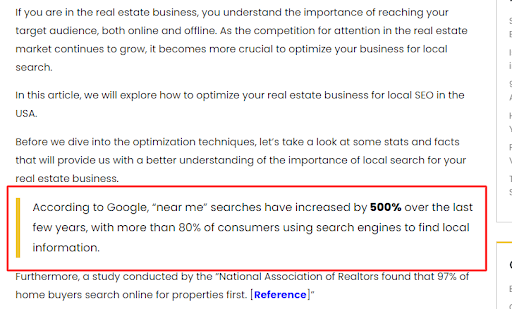
Link Building Checklist
Link building is a crucial strategy to enhance your website’s visibility, authority, and search engine rankings.
A well-executed link building strategy can help your site earn valuable backlinks from reputable sources, signaling to search engines that your content is trustworthy and relevant.
In this link building checklist, we will explore the essential steps and best SEO practices to guide you in acquiring high-quality links that can boost your website’s rankings and organic traffic.
1. Replicate your competitor’s links
Analyzing your competitors’ backlinks can provide valuable insights into their link-building strategies.

Identifying the sites linking to your competitors, you can try to replicate those links for your own website.
This process involves reaching out to the same websites and offering valuable content or resources in exchange for backlinks.
Remember, it’s not about copying their content but learning from their successes and adapting those strategies to fit your unique brand.
2. Reclaim lost links
Over time, websites may change, and some of your valuable backlinks may become broken or lost. Don’t let these opportunities slip away.

Use tools like Ahrefs to monitor and identify broken backlinks, and then contact the website owners to reclaim or fix those links. Re-establishing these connections can revive your link profile and maintain a strong online presence.
3. Outreach for link building
Outreach is a proactive approach to link building where you reach out to other website owners, bloggers, or influencers within your niche.
Engage in personalized and meaningful conversations, demonstrating how your content can benefit their audience.

Building genuine relationships can lead to organic backlinks and long-term collaborations that mutually benefit both parties.
4. Tell more people about your content
Even the most exceptional content won’t generate links on its own. Don’t be shy about promoting your content through various channels, such as social media, newsletters, and relevant forums.
The more people who see and engage with your content, the higher the likelihood of others linking back to it.
5. Pitch resource pages
Many websites have resource pages that link to valuable and informative content in their niche.
Look for such opportunities within your industry and reach out to these websites, suggesting your content as a valuable addition to their resource pages.
When your content is seen as a useful resource, website owners are more likely to link to it.
6. Check for toxic links
Not all backlinks are beneficial. Some links can harm your website’s reputation and rankings, especially if they come from spammy or low-quality sites.

Regularly audit your backlink profile using tools like MOZ that identify toxic links. Once you identify them, take steps to disavow or remove these harmful links to protect your website’s credibility.
7. Remove spammy backlinks
Similar to toxic links, spammy backlinks can negatively impact your website’s SEO efforts.
Reach out to the webmasters of websites linking to you from irrelevant, low-quality, or suspicious sources.
Politely request the removal of such links, and if unsuccessful, use Google’s Disavow Tool to dissociate your site from these undesirable links.
